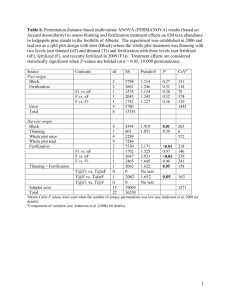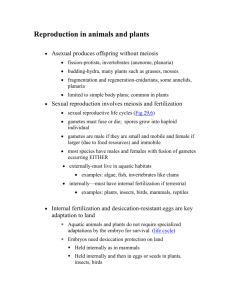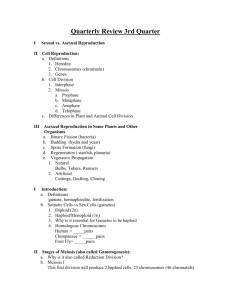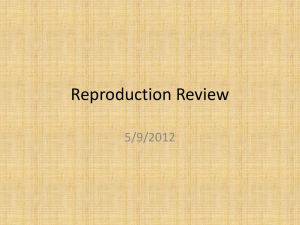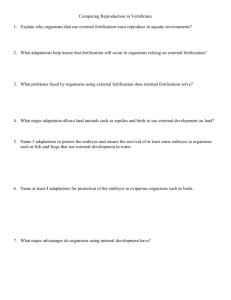Internal vs External Reproduction a comparison
advertisement
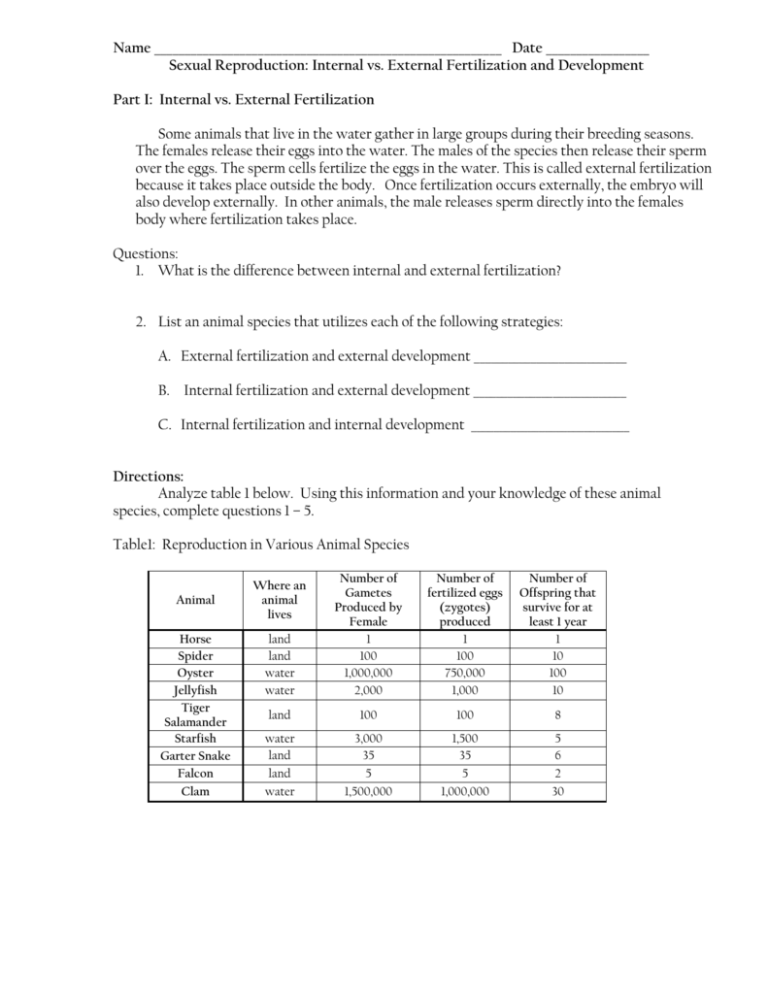
Name _________________________________________________________ Date _________________ Sexual Reproduction: Internal vs. External Fertilization and Development Part I: Internal vs. External Fertilization Some animals that live in the water gather in large groups during their breeding seasons. The females release their eggs into the water. The males of the species then release their sperm over the eggs. The sperm cells fertilize the eggs in the water. This is called external fertilization because it takes place outside the body. Once fertilization occurs externally, the embryo will also develop externally. In other animals, the male releases sperm directly into the females body where fertilization takes place. Questions: 1. What is the difference between internal and external fertilization? 2. List an animal species that utilizes each of the following strategies: A. External fertilization and external development ___________________________ B. Internal fertilization and external development ___________________________ C. Internal fertilization and internal development ____________________________ Directions: Analyze table 1 below. Using this information and your knowledge of these animal species, complete questions 1 – 5. Table1: Reproduction in Various Animal Species Animal Horse Spider Oyster Jellyfish Tiger Salamander Starfish Garter Snake Falcon Clam land land water water Number of Gametes Produced by Female 1 100 1,000,000 2,000 Number of fertilized eggs (zygotes) produced 1 100 750,000 1,000 Number of Offspring that survive for at least 1 year 1 10 100 10 land 100 100 8 water land land water 3,000 35 5 1,500,000 1,500 35 5 1,000,000 5 6 2 30 Where an animal lives Questions: 1. Fill in the table below by placing the names of the organisms from table 1 in the correct columns. **If number of zygotes produced is greater than 150, external fertilization occurred. ** Internal Lives in Water Lives on Land Fertilization Fertilization External Internal External 2. Write a general statement that explains where fertilization will occur (internally or externally) based on where an organism lives (water or land). 3. A. List the four organisms that produce the most female gametes and zygotes. B. Do all of the female gametes get fertilized? __________ Support your answer. C. Where do the organisms that produce the most gametes live? ______________ D. Hypothesize why these organisms need to produce so many gametes/zygotes. 4. What kind of fertilization do animals in the water typically use? _________________________ Why is this possible in water and not on land? 5. In which type of fertilization (internal or external) is there more success for the sperm (more likely to reach an egg)? __________________________ Support your answer. 6. Place an X in either internal or external based on what you have learned so far. Fertilization Animal Number of zygotes produced Blue Fish 15,000 Chameleon Leech Lobster Rainbow trout Crayfish Lizard Cow Blue Crab 8 60 8,500 4,000 40 10 1 950,000 Internal External Part II: Internal vs. External Development Development of the embryo after internal fertilization can happen in one of two ways. In some animal species, the females will actually lay the fertilized egg and the embryo will develop outside of her body. In other animals, the embryo will implant in to the uterus and the embryo will develop inside of the female. Directions: Analyze table 2 below. Using this information and your knowledge of these animal species, complete questions 7 – 13. Table 2: Reproduction in Various Animal Species with Internal Fertilization Parental Care Animal Horse Spider Tiger Salamander Garter Snake Falcon land land Number of fertilized eggs (zygotes) produced 1 100 land 100 land land 35 5 Where an animal lives Yes No X X X X X Number of Offspring that survive for at least 1 year 1 20 8 3 2 Questions: 7. Fill in the table below by placing the names of the organisms from table 2 in the correct columns. **If number of zygotes produced is greater than 50, external development occurred. ** Lives on Land Development Internal External 8. Hypothesize why species with more than 40 zygotes all have external development. 9. When animals provide parental care do they have many or a few offspring? _____________ Hypothesize why this occurs. 10. Which two animals produce the same number of zygotes? 11. Even though the species in question #10 produce the same number of zygotes, they do not have the same number of offspring that survive for at least 1 year. Explain why this difference in survival rates occurs. 12. A black bear had 12 babies and 7 survived. Did the bear provide parental care? _______ 13. A centipede had 10,000 babies and 46 survived. Did it provide parental care? _________ 14. Place an X in either internal or external development. Development Tarantula Number of zygotes produced 100 Cow 1 Animal Ape 1 Robin 3 Guppies 40 Internal External Part III: Practice Regents Questions 1. Which type of fertilization and development is exhibited by birds and many reptiles? (1) Internal fertilization and external development (2) Internal fertilization and internal development (3) External fertilization and external development (4) External fertilization and external development 2. Compared to animals that carry on internal fertilization, animals that carry on external fertilization usually (1) Produce fewer eggs (3) Display more parental care (2) Reproduce in water (4) Reproduce on land Use the diagrams below to answer questions 3 – 5. 3. Which diagram represents a type of organism that uses external fertilization for the production of offspring? (1) A (2) B (3) C (4) D 4. Which type of fertilization does organism D carry out? _____________________ Support your answer. 5. Which organism would: (A) Produce the most female gametes ______________________ Support your answer. (B) Produce the least female gametes ______________________ Support your answer. 6. The production of large numbers of eggs is necessary to insure the survival of most (1) Molds (2) Mammals (3) Fish (4) Yeasts 7. Examine the diagrams below. Which organism(s) have the characteristics listed below? (1) A, only (2) C, only (3) A and E (4) D and E 8. Most organisms that live on land have adaptations for (1) Internal fertilization and external development (2) Internal fertilization and internal development (3) External fertilization and external development (4) External fertilization and external development 9. Which characteristic of sexual reproduction has specifically favored the survival of animals that live on land? (1) Fusion of gametes in the outside environment (2) Male gametes that may be carried by the wind (3) Fertilization within the body of the female (4) Female gametes that develop within ovaries

